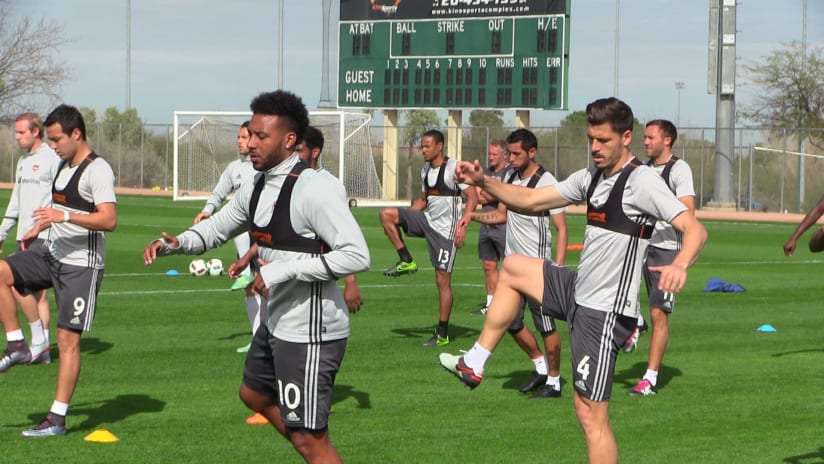Throughout the preseason, photos from training have shown Houston Dynamo players wearing tight-fitting black bibs under—or in some cases over the top of—their training shirts. You may have wondered what those strange additions to the training kit might be. To get the answer, HoustonDynamo.com caught up with Dynamo fitness coach Paul Caffrey.
“Essentially, that’s our GPS system,” Caffrey said. “There’s maybe 200 data points that can be measured, but we ultimately measure or we do pay attention to player distance that they cover during the practices, during the games. We also measure the overall movement of each player, which is represented by a ‘player load’ value, which is essentially their work number. In addition, we measure the intensity and explosion of their movements. It essentially tells us the overall load that they had during the session.”
The system is comprised of the now-familiar black bib, a heart rate monitor and a GPS module that slips into a pocket between the player’s shoulder blades. The GPS module creates a small bump under the player’s jersey making them look slightly hunched over. At this point, pulling on the bibs is just part of the routine for players, as normal as lacing up their boots, and Caffrey said that’s an important component of the analysis.
“They wear them every day. In order for us to make accurate assumptions, we need to see that they’re wearing it because no one or two or three data points means anything in and of themselves; it’s the volume of work,” he said.
That analysis of the volume of work allows Caffrey and his team to monitor not only a player’s fitness level, but look for trends that may, if not altered, lead to injuries down the road.
“Again, no one data point means anything, but if you have three, four, five sessions in a row where you start to see a particular player is covering more distance and his player load is slightly higher than everybody else’s,” Caffrey said,“Then that’s something that I’ll bring to the coaches and say perhaps we need to monitor this player closely. If there’s a way to reduce some of the work that he’s doing by reorganizing the drill for him or manipulating how he plays in a drill, then that can be a benefit also.”
Naturally, the demands of each position are different, meaning that Caffrey and his staff can’t afford to take a one-size-fits-all approach to training. The GPS-enabled bibs allow the fitness coaches to establish baselines for each player based on what he’s expected to do on the pitch and plan their work accordingly. Even within a given system, the requirements for players who nominally play the same position such as wide midfielders or outside backs, may differ greatly, so the staff must create individual profiles.
Equally important as the data collected from the bibs is direct and honest feedback from the players themselves. Caffrey and his team work to create a dialogue with each player that takes a holistic view, not just what happens between the white lines on the pitch.
“For me, it’s vital just to open up the lines of communication with the player because you can look at a lot of data points and you can have a lot of information, and sometimes the information and the charts and the data will tell you that the player is good to go,” he said. “But then you talk to the player and perhaps he didn’t sleep too well, perhaps he’s got other issues going on. Because life is full of stressors, and any stressor that is placed upon the player, it affects how you play.”
Perhaps it’s fitting that the Daytona 500 took place over the weekend, considering the analogy Caffrey used to explain a player’s performance.
“These guys are high-horsepower race cars. But based on some of the issues that they may have in their lives, whether it’s training or off the field, that can reduce them down to a four-cylinder car, and a four-cylinder car is not going to perform the same,” Caffrey said. “The desire is always going to be there and they will always get their work done, but then the cost to the engine if it’s not running efficiently is going to be greater, so that’s why we’re always trying to red flag as much as we can and get on top of things early so, again, we’re dealing with that fully powered-up athlete.”
Ultimately, Caffrey said, his aim is to give head coach Owen Coyle as many options as possible when he fills out the team sheet on gameday.
“You really have to create those individual profiles, and then once you have their norms then it’s easier to take care of them and try to make sure that they’re in an optimal state to be fit,” he said. “Our main goal is to make sure that that everyone is available on Saturdays for Owen to choose the ones that he wants to choose, and also to make sure that all of those players are in the best shape that they can be in.”


